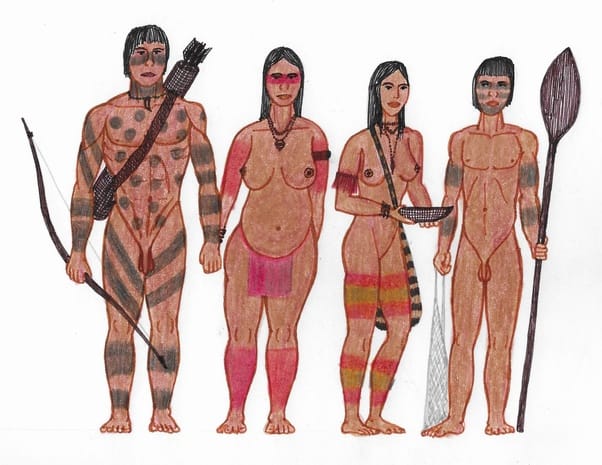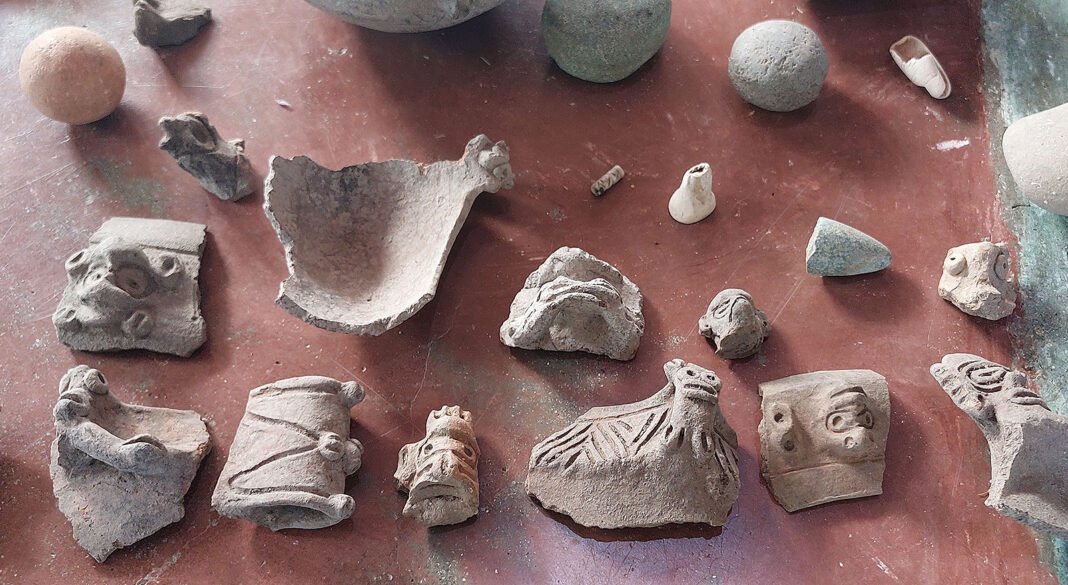The Taino were one of the ethnic groups that lived in pre-Columbian America. They inhabited the Caribbean Sea region, in what today are countries such as Cuba, the Dominican Republic, the island of Puerto Rico, the Bahamas, and many other islands.
The Taino, specifically those who lived in the islands of the Bahamas, were the first indigenous people that the Spaniards found when they arrived in America.
They did not have the same concept of modesty as the Europeans, so it was their custom that men, children and unmarried women went around naked. Married women showed their married status by covering their sex with a small cloth apron which they called Nagua.
To adorn themselves, they used paints made with different minerals such as charcoal (black) ocher (yellow) and fruits such as achiote (red). They wore necklaces and bracelets.

The Taino people, the indigenous inhabitants of the island, have left an indelible mark on the history, culture, and identity of the Dominican Republic. Unveiling the story of the Taino people not only sheds light on the island’s rich heritage but also honors the resilience and enduring spirit of this vibrant indigenous civilization.
They were dedicated to hunting, fishing and agriculture.
A highly organized society
The Taino people thrived in the Caribbean long before Christopher Columbus set foot on these shores in 1492. They inhabited the Greater Antilles, including present-day Cuba, Puerto Rico, Jamaica, and the Dominican Republic. The Taino were a highly organized society, with complex social structures, a sophisticated agricultural system, and a rich spiritual and artistic heritage.
Taino’s relationship with the natural world
The Taino’s relationship with the natural world was deeply intertwined. They revered nature and saw themselves as an integral part of it. The land provided them with sustenance, and they cultivated crops such as maize, cassava, and yams, employing advanced farming techniques like terracing. They also cultivated cotton, which they used to create textiles and hammocks, showcasing their craftsmanship.
Intricate artistry
One of the most notable aspects of Taino culture was their intricate artistry. The Taino people were skilled artisans who created intricate carvings, pottery, and jewelry. Their artwork often featured motifs inspired by nature, such as animals, plants, and celestial bodies. The iconic stone duhos, ceremonial seats carved with ornate designs, are symbolic of their artistic prowess and spiritual practices.
Spirituality
Spirituality held a central place in Taino society. The Taino believed in a pantheon of deities, with the supreme creator deity known as Yúcahu. They conducted rituals and ceremonies to honor their gods, seeking guidance, protection, and bountiful harvests. These rituals often involved music, dance, and the consumption of a sacred beverage called “cacique,” made from fermented cassava.
The arrval of Columbus brings diseases and forced labor
The arrival of Christopher Columbus marked a pivotal turning point in Taino history. The encounter between the Taino and Europeans brought about significant changes to the indigenous way of life. The introduction of new diseases, forced labor, and colonization led to the decline of the Taino population. Despite this tragic chapter in their history, the Taino legacy endures, interwoven with the fabric of Dominican culture.
Museo del Hombre Dominicano in Santo Domingo
Today, the Dominican Republic pays homage to its Taino heritage through various means. Museums, such as the Museo del Hombre Dominicano in Santo Domingo, showcase Taino artifacts and provide insights into their way of life. The study of Taino language, traditions, and customs has experienced a resurgence, fostering a sense of pride and cultural revival.
Lives on in the Dominican cuisine
Furthermore, Taino influence can be seen in Dominican cuisine, language, music, and art. Traditional dishes like “casabe” (a cassava bread) and “guanábana” (a fruit) reflect the Taino’s culinary contributions. Taino words have been incorporated into the Dominican Spanish dialect, while traditional music instruments, such as the “güiro” (a percussion instrument), continue to be used in Dominican music.
Recognizing the importance of preserving the Taino legacy, efforts are being made to foster understanding, appreciation, and respect for this ancient culture. Collaborative projects between archaeologists, historians, and local communities aim to uncover more about Taino history and promote cultural exchange.
The Taino people may have faced hardships and obstacles throughout their history, but their spirit endures in the hearts and minds of the Dominican people. By exploring the Taino legacy, we honor their contributions, celebrate their resilience, and acknowledge the deep-rooted connection between the modern Dominican Republic and its indigenous past. The Taino people’s story is a testament to the strength of indigenous cultures worldwide and a reminder of the importance of preserving and valuing our diverse heritage.


